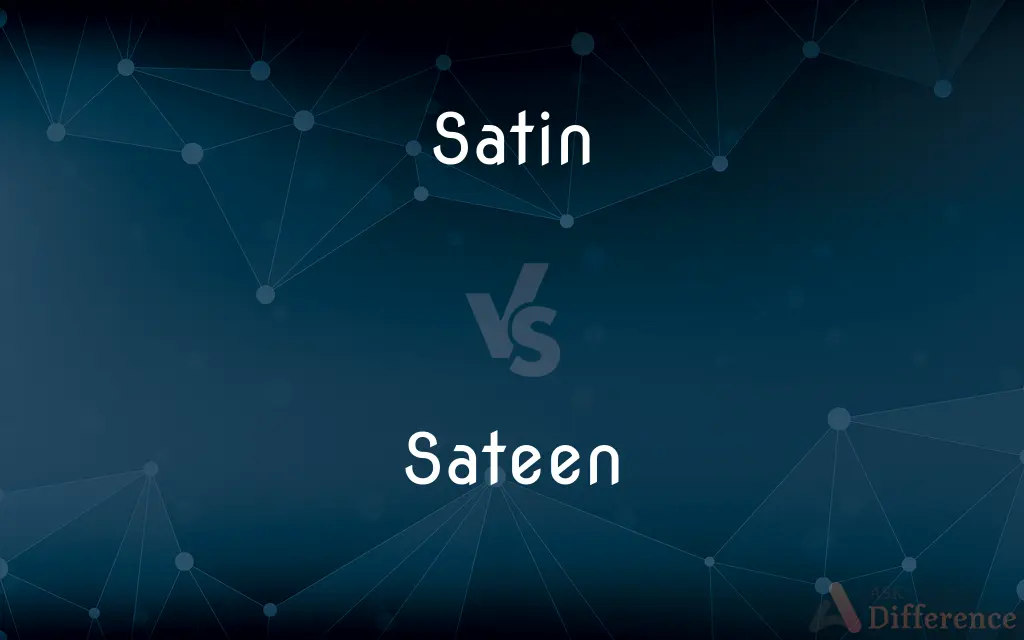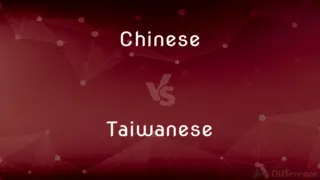Satin vs. Sateen — What's the Difference?
By Maham Liaqat & Fiza Rafique — Updated on March 30, 2024
Satin is a weave that typically uses silk, nylon, or polyester, offering a glossy surface, whereas sateen is a cotton-based fabric with a similar sheen achieved through a different weave technique.

Difference Between Satin and Sateen
Table of Contents
ADVERTISEMENT
Key Differences
Satin and sateen fabrics are both known for their smooth texture and lustrous finish, making them popular choices for luxury bedding, apparel, and other textiles. The primary distinction lies in their material composition and weave technique. Satin, often made from silk, nylon, or polyester, provides a high gloss on one side with a dull back, thanks to its weave pattern. Sateen, on the other hand, is primarily made from cotton, giving it a softer feel while still maintaining a subtle sheen due to the mercerization process it undergoes.
The origin of satin can be traced back to the Middle Ages, originating from China and gaining popularity in Europe through trade. Its luxurious texture and sheen made it a symbol of wealth and status. Sateen, developed later, offered a more affordable alternative to satin, providing a similar sheen but with the comfort and durability of cotton. This accessibility has made sateen a popular choice for bedding and interior textiles.
When it comes to durability and maintenance, sateen is generally more durable and easier to care for than satin made from silk. Cotton's natural fibers allow sateen to withstand more washes and wear, making it a practical choice for items that require regular laundering. Satin, especially silk satin, requires more delicate handling and often dry cleaning, making it better suited for luxury items or clothing that is not worn daily.
In terms of feel, satin fabrics tend to have a smoother, more slippery surface, which can feel cooler to the touch. This makes satin a preferred choice for lingerie, evening wear, and other garments where drape and flow are desirable. Sateen, while still smooth, offers a slightly heavier and warmer feel, making it ideal for bedding and colder weather apparel.
Despite these differences, both satin and sateen bring elegance and comfort to a variety of applications. Their respective characteristics cater to different needs and preferences, whether one is looking for the ultimate luxury experience with satin or the cozy, durable comfort of sateen.
ADVERTISEMENT
Comparison Chart
Material
Silk, nylon, polyester
Cotton
Weave Technique
4 or more fill or weft yarns floating over a warp yarn
Fewer floats in comparison to satin, usually in a fill or weft face weave
Finish
High gloss on one side, dull on the other
Subtle sheen, softer feel
Durability
Less durable, requires careful handling
More durable, easier to launder
Use
Lingerie, evening wear, luxury items
Bedding, interior textiles, apparel
Compare with Definitions
Satin
Cooler to the touch, suitable for formal attire.
He chose a satin tie to add a touch of sophistication to his suit.
Sateen
Mercerization enhances its luster and strength.
The mercerized sateen fabric had a beautiful sheen and was surprisingly strong.
Satin
Less durable and requires careful maintenance.
Her satin blouse required dry cleaning to maintain its sheen.
Sateen
Provides a warm and cozy feel, suitable for bedding.
Sateen pajamas are perfect for a comfortable night's sleep.
Satin
Known for its high sheen and drape.
Satin sheets are synonymous with luxury and comfort.
Sateen
A cotton fabric with a soft sheen, resulting from a specific weave.
The sateen sheets added a subtle elegance to the bedroom.
Satin
A glossy, smooth fabric often made from silk, offering a luxurious feel.
The satin gown flowed elegantly with every step she took.
Sateen
Durable and easy to care for, ideal for daily use.
Her favorite sateen blouse held up well after many washes.
Satin
Historical symbol of wealth and status.
In medieval Europe, satin garments were worn by the aristocracy.
Sateen
Offers a more affordable alternative to satin with similar aesthetics.
Opting for sateen curtains gave the room a luxurious look without breaking the bank.
Satin
A satin weave is a type of fabric weave that produces a characteristically glossy, smooth or lustrous material, typically with a glossy top surface and a dull back. It is one of three fundamental types of textile weaves alongside plain weave and twill weave.
Sateen
Sateen is a fabric made using a satin weave structure but made with spun yarns instead of filament.The sheen and softer feel of sateen is produced through the satin weave structure. Warp yarns are floated over weft yarns, for example four over and one under.
Satin
A smooth, often silk fabric that is woven with a glossy face and a dull back.
Sateen
A usually cotton fabric that has a satinlike finish.
Satin
A garment made of this fabric.
Sateen
A type of cotton cloth with a shiny surface and dull back, woven using the technique that, when applied to silk or nylon, results in cloth called satin.
Satin
A kind of paint that dries to a smooth shiny finish.
Sateen
A kind of dress goods made of cotton or woolen, with a glossy surface resembling satin.
Satin
Made of or covered with satin.
Sateen
A cotton fabric with a satiny finish
Satin
Glossy, sleek, and smooth.
Satin
A cloth woven from silk, nylon or polyester with a glossy surface and a dull back. (The same weaving technique applied to cotton produces cloth termed sateen).
Satin
Semigloss.
Satin paint
Satin
(transitive) To make (paper, silver, etc.) smooth and glossy like satin.
Satin
A silk cloth, of a thick, close texture, and overshot woof, which has a glossy surface.
Cloths of gold and satins rich of hue.
Satin
A smooth fabric of silk or rayon; has a glossy face and a dull back
Common Curiosities
How are satin and sateen different in terms of durability?
Sateen is generally more durable and easier to care for than satin, making it suitable for items that require regular washing.
Can satin be made from cotton?
Traditional satin is made from silk, nylon, or polyester, not cotton. Cotton-based fabrics with a similar sheen are referred to as sateen.
What is satin?
Satin is a weave that results in a fabric with a glossy surface and a dull back, often made from silk, nylon, or polyester.
Why is satin considered luxurious?
Satin's smooth texture and high gloss, especially when made from silk, have historically been associated with luxury and exclusivity.
Which is better for warm weather, satin or sateen?
Satin is cooler to the touch and may be more comfortable for warm weather, especially if made from silk.
How is the sheen on sateen achieved?
The sheen on sateen is achieved through the mercerization process, which also increases its strength.
Can sateen have the same glossy appearance as satin?
Sateen can have a similar sheen but it is usually subtler compared to the high gloss of satin.
Why choose sateen over satin?
Sateen offers a combination of softness, durability, and ease of care, making it a practical choice for everyday luxury.
Do both satin and sateen require special care?
Satin, particularly silk satin, requires more delicate care, often needing dry cleaning, while sateen is more robust and generally machine washable.
What is sateen?
Sateen is a cotton fabric that has been treated to give it a sheen similar to satin but with a softer feel.
Are satin and sateen environmentally friendly?
The environmental impact depends on the source materials and production processes. Cotton sateen is often considered more sustainable than synthetic satins.
What types of products are commonly made from satin?
Satin is popular for evening wear, lingerie, and luxury bedding due to its smooth texture and elegant drape.
Is sateen good for bedding?
Yes, sateen is an excellent choice for bedding due to its softness, durability, and warmth.
Is there a price difference between satin and sateen?
Generally, satin, especially silk satin, can be more expensive than sateen due to the cost of silk and the manufacturing process.
Are there any common misconceptions about satin and sateen?
A common misconception is that satin and sateen are the same; while they share similarities in appearance, they differ significantly in material and weave.
Share Your Discovery

Previous Comparison
Abstract vs. Surrealism
Next Comparison
Chinese vs. TaiwaneseAuthor Spotlight
Written by
Maham LiaqatCo-written by
Fiza RafiqueFiza Rafique is a skilled content writer at AskDifference.com, where she meticulously refines and enhances written pieces. Drawing from her vast editorial expertise, Fiza ensures clarity, accuracy, and precision in every article. Passionate about language, she continually seeks to elevate the quality of content for readers worldwide.













































